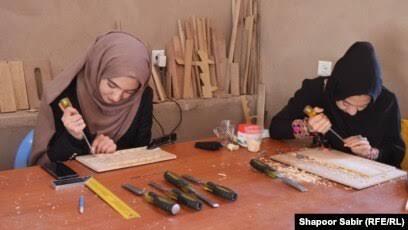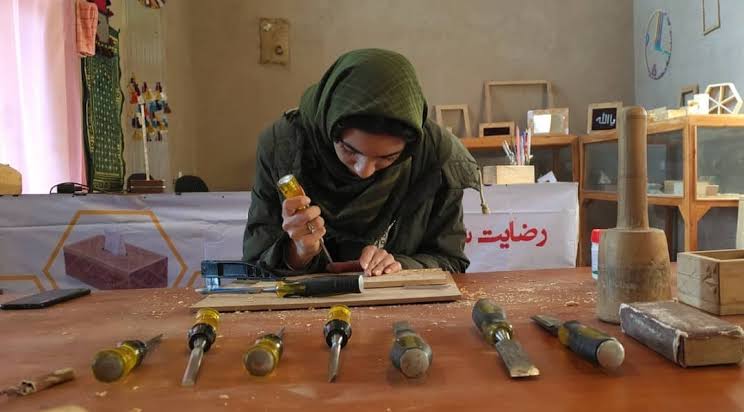
Share:
Inside a decaying old building in Kabul’s Pul-e-Surkh area, surrounded by sawdust, the smell of fresh wood, and the tapping of tiny hammers, a group of young girls are quietly crafting their own worlds. These are girls who have been barred from school, yet they refuse to let silence and restriction shape their futures. In this small wood-carving workshop, hope is molded by their hands and hearts
Amid the constant noise and chaos of Kabul’s Pul-e-Surkh market, in a small upstairs room of a crumbling building, a quiet revolution is underway. The scent of wood shavings fills the air, the gentle scrape of files and soft taps of hammers echo through the space — and in the middle of it all, young girls sit with sleeves rolled up, etching their dreams into blocks of wood.
This modest workshop is more than a classroom. It is a safe space for girls who have been cut off from formal education — a place where learning continues, even if classrooms have been closed to them.
A Modest Beginning, a Bold Purpose
The workshop was founded two years ago by 25-year-old Sofia Khaleqi, a resident of Kabul who once stood where her students sit today. She learned wood carving five years ago, and with just 50,000 Afghanis of her own savings, she set up this humble space to pass her knowledge on.
"When schools and universities were closed to girls, I knew I couldn’t stay silent," she says. "Even if it's small, I wanted to open a window for them to keep learning and creating."

Today, nearly 20 girls attend her workshop in rotating shifts. They pay a small monthly fee — 500 Afghanis — which Sofia uses to cover rent and basic tools. She says she doesn’t make a profit from the work, but that’s not her aim.
"Just keeping this space open is a victory," she adds.
More Than Just Wood and Tools
The challenges are many. Tools are expensive, raw materials are hard to come by, and there’s little market for the girls’ artwork.
"People can barely afford food these days. Who’s going to buy decorative carvings?" Sofia says with a faint smile. "Most of our pieces are shown in exhibitions. We rarely get custom orders."
Yet her commitment remains strong. For Sofia, this work is not just about teaching a skill — it’s about healing, dignity, and resistance.
A Quiet Place to Rebuild Confidence
One of the students, Leelma, used to be in 10th grade before girls’ schools were shut down. Now, she sits at a wooden table, gently shaping a carving with careful hands.
"I felt lost when I could no longer go to school," she says. "I wanted to learn something — and this art called to me. At first, it was hard, but now I enjoy working with wood. It calms the mind and keeps the bad thoughts away."

Another girl, Afsana, has been attending classes here for three months. Like Leelma, she was forced to leave school.
"I wanted to build something for myself," she says. "Something I can rely on. That’s why I chose to learn carving. One day, I hope I can teach others too."
A Space for Sisterhood and Strength
The workshop isn’t just a place to learn a craft — it’s a space for emotional connection and mutual support. The girls talk, laugh, and sometimes fall silent together. Their presence gives each other strength.
The room is small but thoughtfully arranged. Tables are lined up neatly, carving tools are stacked in order, and colorful wooden art pieces hang on the walls. There’s no luxury here, but there’s warmth, intention, and hope.
Art Can’t Replace Education — But It Keeps the Flame Alive
While Sofia believes in the power of art, she knows its limits.
"No craft can replace formal education. Art is beautiful and healing, but girls deserve classrooms, teachers, and diplomas. My dream is for every girl to go back to school and university — to learn freely and contribute to society."
Where the Chisel Meets Resistance
In a country where girls are banned from secondary and higher education, small spaces like Sofia’s workshop become beacons of resilience. These rooms may not have blackboards or textbooks, but they are rich in something equally vital: courage.
Outside, Pul-e-Surkh remains noisy and crowded. Cars pass, vendors shout, people rush by. But upstairs, in this little room filled with sawdust and hope, life goes on — carved into the wood, shaped by the hands of girls who refuse to disappear.
Reporter: Sadaf Rahimi – Rahil News
Note: The names used in this report have been changed for security reasons.




